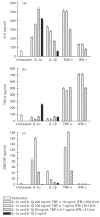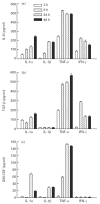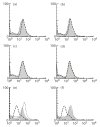A variety of cytokines and immunologically relevant surface molecules are expressed by normal human skeletal muscle cells under proinflammatory stimuli
- PMID: 9737670
- PMCID: PMC1905062
- DOI: 10.1046/j.1365-2249.1998.00664.x
A variety of cytokines and immunologically relevant surface molecules are expressed by normal human skeletal muscle cells under proinflammatory stimuli
Abstract
Muscle is an attractive target for gene therapy and for immunization with DNA vaccines and is also the target of immunological injury in myositis. It is important therefore to understand the immunologic capabilities of muscle cells themselves. In this study, we show that proinflammatory stimuli induce the expression of other cytokines such as IL-6, transforming growth factor-beta (TGF-beta), and granulocyte-macrophage colony-stimulating factor (GM-CSF) by muscle cells themselves, as well as the up-regulation of human leucocyte antigen (HLA) class I, class II and intercellular adhesion molecule-1 (ICAM-1). Thus, muscle cells have an inherent ability to express and respond to a variety of cytokines and chemokines. The levels of HLA class I, class II and ICAM-1 in inflamed muscle may be affected by the secreted products of the stimulation.
Figures







Similar articles
-
The effect of cytokines on the expression of MHC antigens and ICAM-1 by normal and transformed synoviocytes.Autoimmunity. 1992;12(1):13-9. doi: 10.3109/08916939209146125. Autoimmunity. 1992. PMID: 1352152
-
Selective regulation of ICAM-1 and major histocompatibility complex class I and II molecule expression on epidermal Langerhans cells by some of the cytokines released by keratinocytes and T cells.Eur J Immunol. 1994 Nov;24(11):2889-95. doi: 10.1002/eji.1830241146. Eur J Immunol. 1994. PMID: 7957579
-
Upregulation of HLA class II, but not intercellular adhesion molecule 1 (ICAM-1) by granulocyte-macrophage colony stimulating factor (GM-CSF) or interleukin-3 (IL-3) in synergy with dexamethasone.Eur Cytokine Netw. 1992 Jul-Aug;3(4):373-80. Eur Cytokine Netw. 1992. PMID: 1358241
-
Immunological capabilities of skeletal muscle cells.Acta Physiol Scand. 2001 Mar;171(3):215-23. doi: 10.1046/j.1365-201x.2001.00823.x. Acta Physiol Scand. 2001. PMID: 11412133 Review.
-
Update on immunopathogenesis in inflammatory myopathies.Curr Opin Rheumatol. 2001 Nov;13(6):461-8. doi: 10.1097/00002281-200111000-00002. Curr Opin Rheumatol. 2001. PMID: 11698721 Review.
Cited by
-
Sepsis-induced myopathy.Crit Care Med. 2009 Oct;37(10 Suppl):S354-67. doi: 10.1097/CCM.0b013e3181b6e439. Crit Care Med. 2009. PMID: 20046121 Free PMC article. Review.
-
Lipoic Acid Exerts Antioxidant and Anti-inflammatory Effects in Response to Heat Shock in C2C12 Myotubes.Inflammation. 2016 Jun;39(3):1160-8. doi: 10.1007/s10753-016-0350-2. Inflammation. 2016. PMID: 27086282
-
Vitamin D receptor agonists: suitable candidates as novel therapeutic options in autoimmune inflammatory myopathy.Biomed Res Int. 2014;2014:949730. doi: 10.1155/2014/949730. Epub 2014 May 7. Biomed Res Int. 2014. PMID: 24895631 Free PMC article. Review.
-
Skeletal muscle as potential central link between sarcopenia and immune senescence.EBioMedicine. 2019 Nov;49:381-388. doi: 10.1016/j.ebiom.2019.10.034. Epub 2019 Oct 26. EBioMedicine. 2019. PMID: 31662290 Free PMC article. Review.
-
Influence of immune responses in gene/stem cell therapies for muscular dystrophies.Biomed Res Int. 2014;2014:818107. doi: 10.1155/2014/818107. Epub 2014 May 19. Biomed Res Int. 2014. PMID: 24959590 Free PMC article. Review.
References
-
- Streilein JW. Peripheral tolerance induction: lessons from immune privileged sites and tissues. Transplant Proc. 1996;28:2066–70. - PubMed
-
- Law PK, Goodwin TG, Fang Q, et al. Human gene therapy with myoblast transfer. Transplant Proc. 1997;29:2234–7. - PubMed
-
- Kim JJ, Bagarazzi ML, Trivedi N, et al. Engineering of in vivo immune responses to DNA immunization via codelivery of costimulatory molecule genes. Nat Biotechnol. 1997;15:641–6. - PubMed
-
- Plotz PH, Miller FW. Animal models of myositis. Mt Sinai J Med (NY) 1988;55:501–5. - PubMed
MeSH terms
Substances
LinkOut - more resources
Full Text Sources
Research Materials
Miscellaneous

